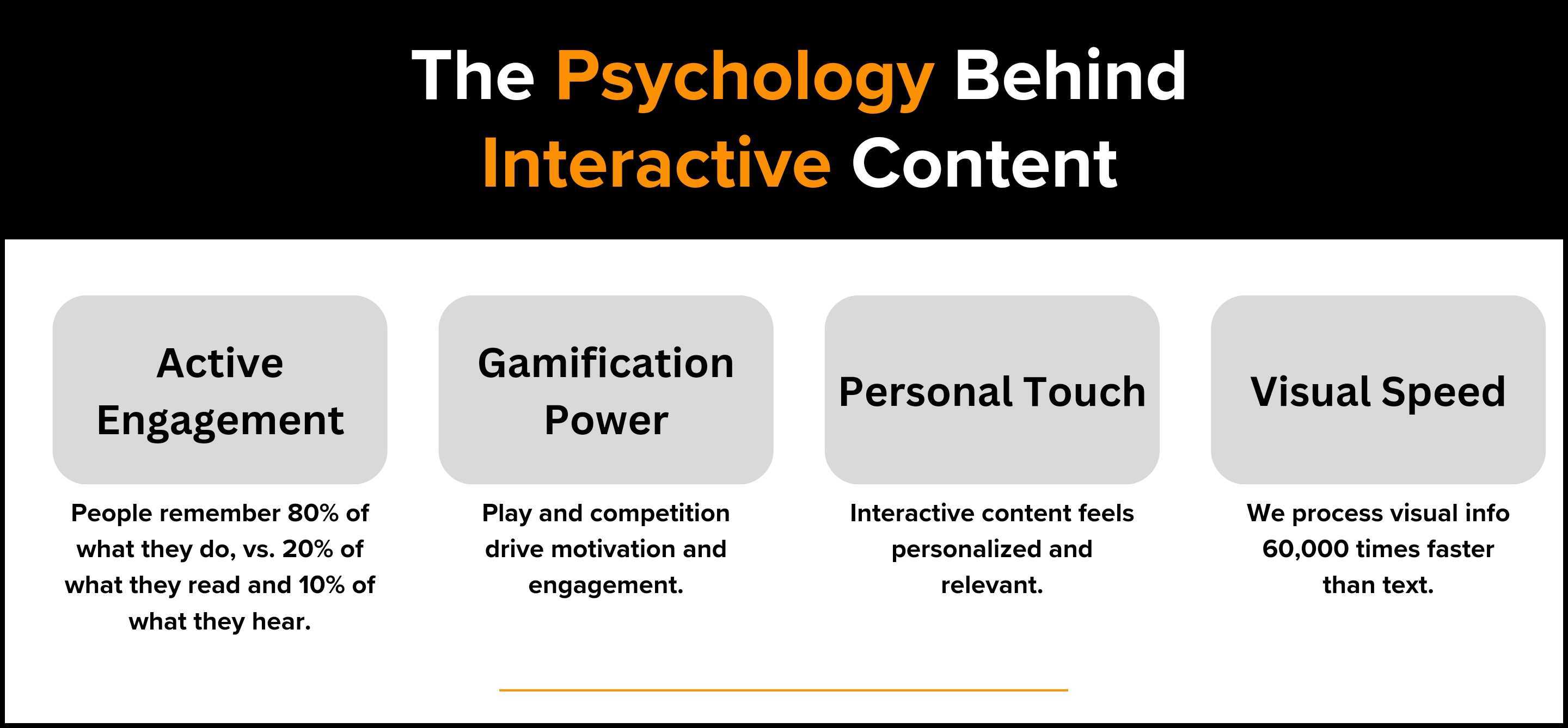Why Some Content Just Clicks with You?
Interactive content marketing is more than just a trend, it's a game changer for engaging your audience. But what's the big deal, and why should you care? If you're just starting in creating interactive content, understanding the psychology behind that can help you launch more engaging and effective campaigns.
What is Interactive Content?
Before diving into psychology, let's clear up what interactive content is. Traditional content, like blog posts or videos, is something your audience reads or watches. It's passive, they're just absorbing information. Interactive content, on the other hand, requires action. Think of quizzes, calculators, or interactive infographics—your audience has to do something with it. This participation makes them feel more involved, which is key to keeping their attention.
Distinguishing Traditional and Interactive Content
Why is interactive content more engaging? The answer lies in how we naturally interact with information. Traditional content is like reading a book—great for information, but not very engaging. Interactive content is like having a conversation—you're actively involved, and that makes it more memorable. Imagine the difference between reading an article on healthy eating versus taking a quiz that tells you which diet suits you best. Which would you remember more?
Common Myths in Traditional Content
Ignoring Engagement
One myth often made is sticking with traditional, static content. Sure, it's easier to create, but it doesn't engage your audience like interactive content does. If your content feels like a one-way street, you're missing out on opportunities to connect with your audience.
Thinking All Content is Equal
Another common myth is thinking that all content engages equally. If you're not incorporating interactive elements, your content might be just another drop in the ocean. Adding interactive features like polls or quizzes can make your content stand out and keep people coming back for more.
Overlooking the Power of Fun
A big and general myth is thinking marketing content should always be serious. Adding fun elements like quizzes or challenges doesn't just make content more enjoyable—it also makes it more effective. People are more likely to engage with and remember content that entertains them.
Missing Out on Data Collection
Not using interactive content to gather data is an oversight. By neglecting this, you're missing out on valuable insights into your audience's preferences and behaviors. Always think about how you can use interactive content to not only engage but also learn more about your audience.
The Psychology Behind Interactive Content
The secret of interactive content lies in how our brains process information and the psychology behind engagement. Let’s break it down:
Active Learning: Engaging the Mind
Research shows that people remember 80% of what they do, compared to just 20% of what they read and 10% of what they hear. This is where active learning comes in. Interactive content, like quizzes, polls, and calculators, requires users to participate actively, rather than passively consuming information. For example, when a user engages with a mortgage calculator, they’re not just reading about interest rates—they’re inputting their own data, making the experience personal and memorable.
Gamification: Tapping into Motivation
Gamification is another powerful psychological tool. It leverages our natural desire for play and competition. Elements like points, levels, and rewards can boost engagement by 50% or more, as they tap into intrinsic motivation. For instance, a simple quiz that offers a reward at the end can increase user participation significantly. This sense of achievement, even in small doses, keeps people engaged and coming back for more.
Personalization: The “Science of Me”
Interactive content also shines because it feels personal. According to a study by Epsilon, 80% of consumers are more likely to make a purchase when brands offer personalized experiences. When users interact with personalized quizzes or receive tailored feedback, they feel understood and valued. This connection fosters trust and loyalty, making it easier to guide them toward conversion.
Visual Engagement: Processing Information Faster
Humans process visual information 60,000 times faster than text. Interactive content often includes visual elements, which makes it not only more engaging but also easier to understand and remember. For example, an interactive infographic can convey complex data quickly and clearly, increasing the likelihood that users will retain the information.
Interactive content isn’t just about boosting engagement, it’s also a valuable tool for collecting user data. Every click, scroll, or answer reveals insights about your audience. This data allows you to fine-tune your targeting and craft more personalized content. For instance, if users consistently select specific answers in a quiz, you can create future content that aligns with those interests.
Read more: How to Track Your Content's Impact

Why Interactive Content Matters
Interactive content isn’t just a trend. It's a key strategy for crafting engaging, memorable, and effective marketing campaigns. By understanding the psychology behind its success and avoiding common myths, you can fully leverage its potential. So, as you plan your next content piece, ask yourself: How can I make this interactive?
Explore more: Why These 6 Features Are Essential for Interactive Content
Author 
The fastest way to build digital experiences. We empower businesses to convert PDFs, presentations and other content into interactive experiences & webpages with instant branding, analytics & more.